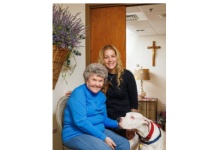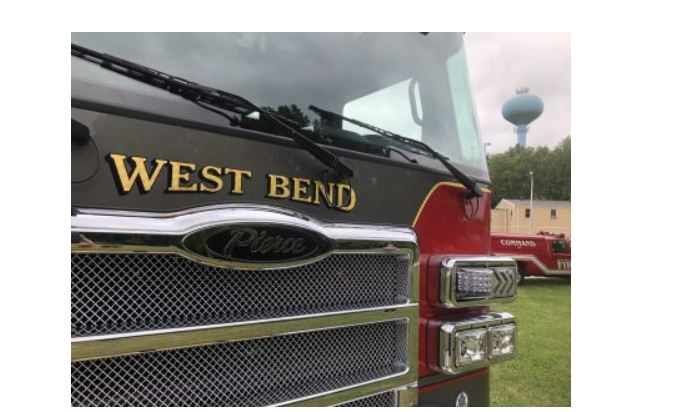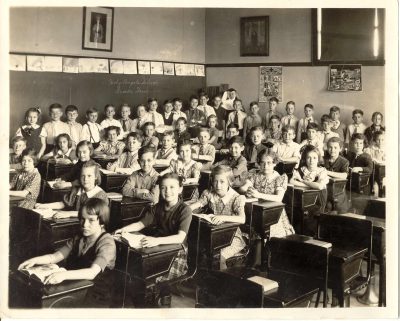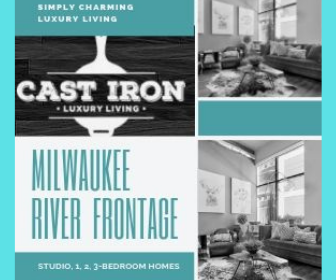West Bend, WI – Over the last 15 years, Dave Bohn has been writing down memories of his childhood, growing up on the family farm just south of West Bend on Hwy P. He hopes his writings will preserve the often-overlooked stories of ordinary farmers and everyday farm life in rural Washington County during the Great Depression through the eyes of a local farm boy.
Memories of a Farm Kid at Holy Angels School
I spent six years at Rusco School, a little one-room rural school, two miles south of West Bend on Hwy 45 (now Hwy. P) and Rusco Drive. For third and fourth grades I went to Holy Angels School in West Bend. That was in 1937 and 1938 when the school was on the northeast corner of Eighth Avenue and Elm Street, across the street from the church. At that time, if you were Catholic, you were to go to a Catholic school to receive your First Holy Communion. My brothers, my sister, and I all went to Holy Angels School, as did my dad (the school was located at the southeast corner of Hickory and 7th Avenue when my dad was a boy).
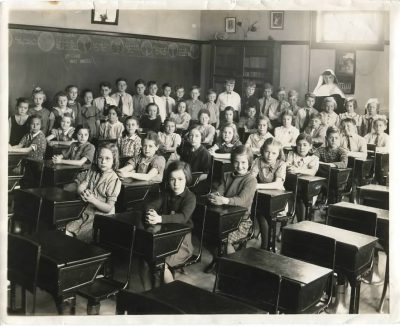
Sister Mary Ann was my 3rd-grade teacher and Sister Alice was my 4th-grade teacher. They wore a full habit, which was required at that time. Third grade was really tough for me, as the school expected more from you than the teachers did at Rusco School. I did pass into fourth grade though, but just barely by the skin of my teeth. That was pretty common at the time; kids from the little one-room country schools struggled and it was really pretty hard to get passed into the next grade.
I was a shy kid back then, so I didn’t get into much trouble in my time at Holy Angels.
Third grade was when we made our First Communion. Father Stehling and Father Wurtzlinski were the priests at that time at Holy Angels and we had to make Confession a few days before. I guess I wasn’t the best child so Mom kept me in the house during this time so I wouldn’t get in trouble because she wanted me to be, as she said, “sin-free.” I guess you could say I was “quarantined”, which was tough for a 7-year-old boy. (But the quarantine was for a much different reason than now.)
I must’ve stayed out of trouble as everything went well and I ended up making my First Communion. We made our First Communion as a group, with the entire third grade. It was on October 21, 1937, during a Thursday Mass…the girls all wore special white Communion dresses and veils, and the boys were dressed up, too. Some boys wore suits if they had them, but most were just dressed up with their nicest clothes and a tie; that’s what I wore. We had to do a little better than our regular school day dress. Back then for school, the girls at all times would wear dresses, no slacks or jeans. And the boys at Holy Angels School had to dress nice, too, but we didn’t have to wear a tie every day, other than for the school picture or a special occasion.
Click HERE to SUBSCRIBE to FREE local news at
Washington County Insider on YouTube
Sister Alice was my fourth-grade teacher. She was older than Sr. Mary Ann and was nice. I did get into trouble one time with her when the boy next to me, Ralph Engelhardt, and I were talking. She only saw me talking and she sent me out in the hall. She made me wait about five minutes before she came out in the hall and read me the “riot act” about how I had disrupted the class. Back in the classroom, everyone was real quiet when I came back in but when school was out for the day, everybody wanted to know what happened in the hallway. That was the last time I talked out of turn. Sr. Alice wasn’t bad, but she did have a way to keep you in line.
We had about 45 kids in each class. I was in a classroom on the first floor in third grade and on the second floor in fourth grade. We had to be at school at 8:00 a.m., but we went to Mass every day before school started. Since we lived a couple of miles south of West Bend, we had to get a ride to school. Mom would drive us in the Model A, or we rode with the Kahlscheuer’s and the Ollinger’s, who were kids on the neighboring farms. No matter if my mom drove us or one of the others did, they all had morning chores to do, so we usually didn’t make it on time for the start of Mass. A lot of other farm kids would show up late for Mass, too. My sister, MaryAnn (Falter), and I would just walk into church, walk up the aisle, and sit down with our class, even though we were late. After church, we’d walk over to the school with our class, take off our coats in the cloakroom and then head to our classroom. Our teacher would start the day in our classroom with a prayer, probably a Hail Mary.
Once a month, all the kids old enough would have Holy Communion at Mass. You could take Holy Communion every day if you wanted, but none of the kids did. On the day that was designated for the school kids to take Holy Communion, they would have sweet rolls that you could buy for 2 or 3 cents after morning mass. This would be our breakfast, as at that time you could not eat anything before receiving Holy Communion; you couldn’t even drink water. So, we were not able to have our normal breakfast at home. We would go down to the school basement after Mass and have our sweet roll before school started. You didn’t have to have a sweet roll, but of course, every kid wanted one.
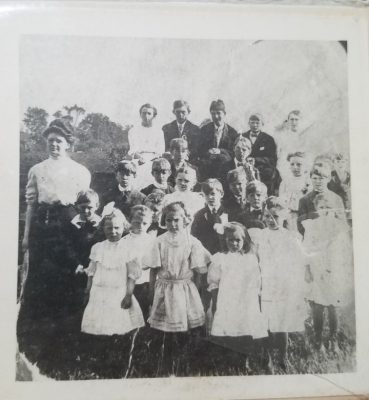
Holy Angels School was very different from Rusco School, as the teacher would teach pretty much all day long and I had to pay attention for the entire day. At Rusco School, we would be called up to the front of the class to spend maybe 20 minutes with the teacher teaching us, and then we’d go back to our desks and study on our own. If we had a question, we would raise our hand and the teacher would call on us and answer our question. That would happen even if the teacher was teaching another grade level at the front of the class at Rusco School.
Things were really different at Holy Angels because there were so many kids in one grade and the teacher only taught one grade, not all eight grades like at Rusco School. It was a better education at Holy Angels, even with the much larger class size. We did have Art class and Music class, but not every day, and we would stay in the same classroom for those classes as Sr. Mary Ann or Sr. Alice would teach Art and Music as well.
We had a 15-minute recess in the morning and in the afternoon, and an hour break at lunch. The entire school had these breaks at one time. Since my mom would be in the barn milking before school, my sister Mary Ann would make us a sandwich most mornings. Most of the time, it was either a peanut butter sandwich or a jelly sandwich that she made with my mom’s homemade jelly. Once in a great while, we’d have a ham sandwich. She’d also put in a doughnut that my mom had made or a cookie and some milk. At first, we carried our lunch to school in just an empty gallon tin pail for Karo syrup. The milk was just in a jar, so it would be at room temperature when we drank it at lunch. Later on, we did get a tin lunch box with a thermos container for milk that my mom had bought for us.
We went to the basement to have lunch each day where they had picnic tables set up. They didn’t serve any food except for the monthly sweet roll day. I think they may have sold milk, but since my family was on a farm, we brought our own milk. All the kids would bring a lunch from home. After we finished eating, we’d go outside for the rest of the hour break, unless the weather was really bad. There wasn’t any playground equipment, just the church gravel parking lot. Since there was not really any yard around the school to play in, we would walk over to the church parking lot at noon or we would just walk around.
Some kids would go to a little store that the Reichert family ran out of their house right near the school. The house had a front porch on it that was used as the store, with the Reichert family living behind in the house. Mrs. Reichert ran the store. They had candy and other things that would attract kids, so it was all kid stuff. Kids would go over to the store and buy bubble gum for one cent. The gum was adhered to a cardboard card, about 2” x 2.” On this card was a black and white photograph of a gruesome war scene from the China and Japan war. The bubblegum series was called “Horrors of War.” We didn’t really have any extra money to buy bubblegum, but we saw the cards that other kids from school had. That was my first exposure to any kind of war.
Sometimes, during recess or lunch at Holy Angels, we’d have enough time to get a game of marbles going. I never was very good at marbles, and the Holy Angels boys were pretty good at it. They knew exactly how the marble would roll on the dirt ground. We’d shoot against the corner of the school building into a small pot that we would dig into the ground. I lost a lot of marbles to those Holy Angels boys and they played for keeps, so I may as well have just given them my marbles.
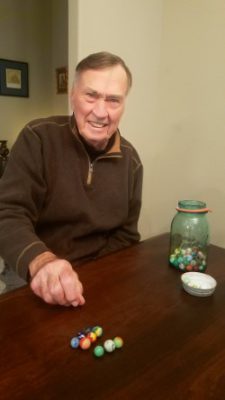
Holy Angels was hard-going for me as it had a much tougher curriculum and, for the most part, the nuns were stricter than the teachers at Rusco School. My mom would help me a lot with my school work, but it was still tough. While I do feel that I got a better education at Holy Angels, it was a totally different way of learning in third and fourth grades than Rusco School.
When I started going to Holy Angels, I really didn’t know any other kids, other than my sister and the neighbor kids we rode to school with, so it was awkward, as I was still a shy kid. For me, being from the farm, some of the kids at Holy Angels seemed better off and smarter, and I felt a little inferior. For us kids, we felt different at Holy Angels, as we were off the farm and there were mostly city kids at Holy Angels. At that time, there was a big, big difference between farm kids and city kids and sometimes we felt like we were second-class because we were from the farm and didn’t have the same kind of education as the city kids.
As for me, I felt more comfortable at the country school, Rusco School. I liked Rusco School as we just had more freedom, it was close to home, and I was with other farm kids, so I felt like I fit in. I went back to Rusco School for fifth grade and made it all the way through eighth grade.
But Holy Angels has always been very important to me and my family. My great grandparents were married there in 1866, and my grandparents and many of my aunts and uncles were married there, too. There were also many First Communions made by my family at Holy Angels, so Holy Angels is a DEEPLY ROOTED part of my family history.




